Locus Devices
List View (Main Table)
-
The table displays all devices with the following default columns: Status, Device Name, Device EUI, Device Model, Home Site, Tags, Inactivity Timeout (min), Last Activity, Battery, Create Date, Asset Name, RSSI (dBm), SNR (dB), PSR (%).
-
Column Configuration (Table Preferences):
- Click the gear icon to open the Table Preferences modal.
- Select which columns to show or hide (e.g., Status, Device Name, Device EUI, Device Model, Home Site, Tags, Inactivity Timeout (min), Last Activity, Battery, Create Date, Asset Name, RSSI (dBm), SNR (dB), PSR (%)).
- Columns can be rearranged by dragging, hidden by deselecting, but resizing is not supported.
- Click Save to apply changes; Cancel to discard.
-
Search and Sort: Use the search bar to find devices by name, Device EUI, or other criteria, and sort columns like Last Activity or Battery in ascending or descending order. Filtering by Home Site is available via the filter dropdown (e.g., Calgary, Kyiv, Madrid (test)).
-
Export Data: Export the table to a .csv file by clicking the CSV button, including data matching current search and filter criteria.
-
Actions (Based on Permissions):
- Click the More Actions (…) button next to a device in the table to open a context menu with Edit and Delete options.
- Admins: Add, edit, or delete devices; pair devices with assets.
- Standard Users: View devices; edit or delete if granted explicit permissions.
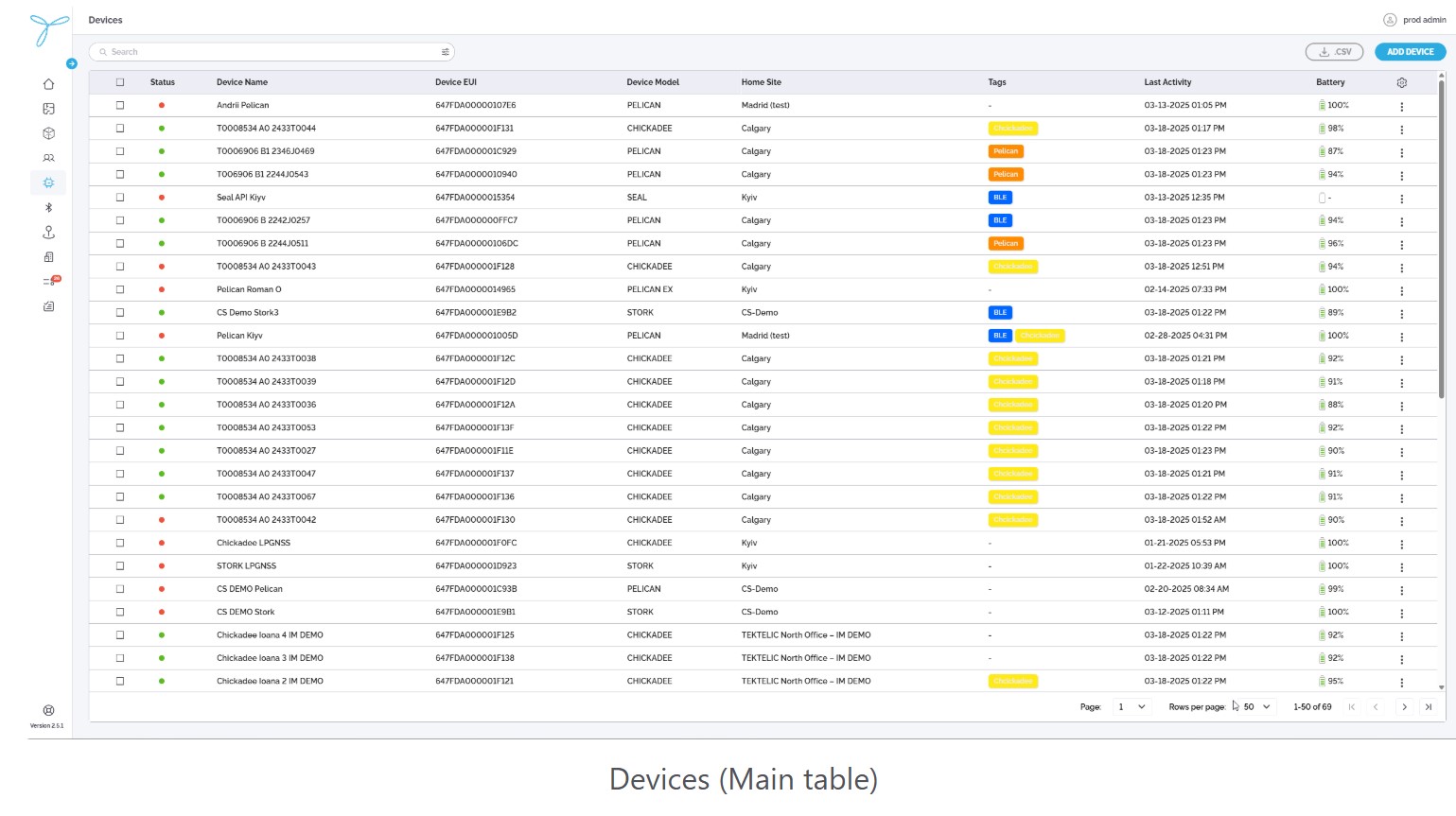
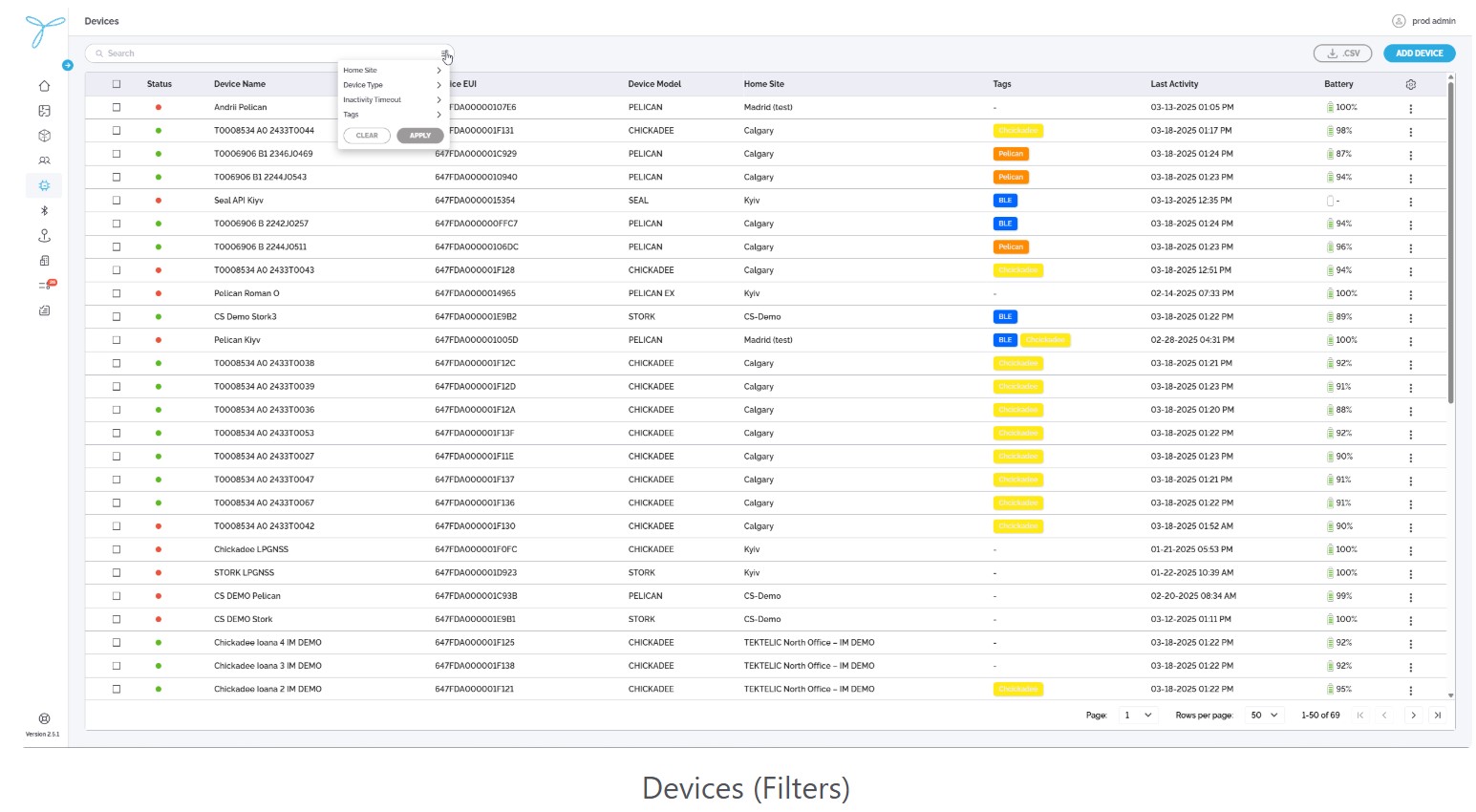
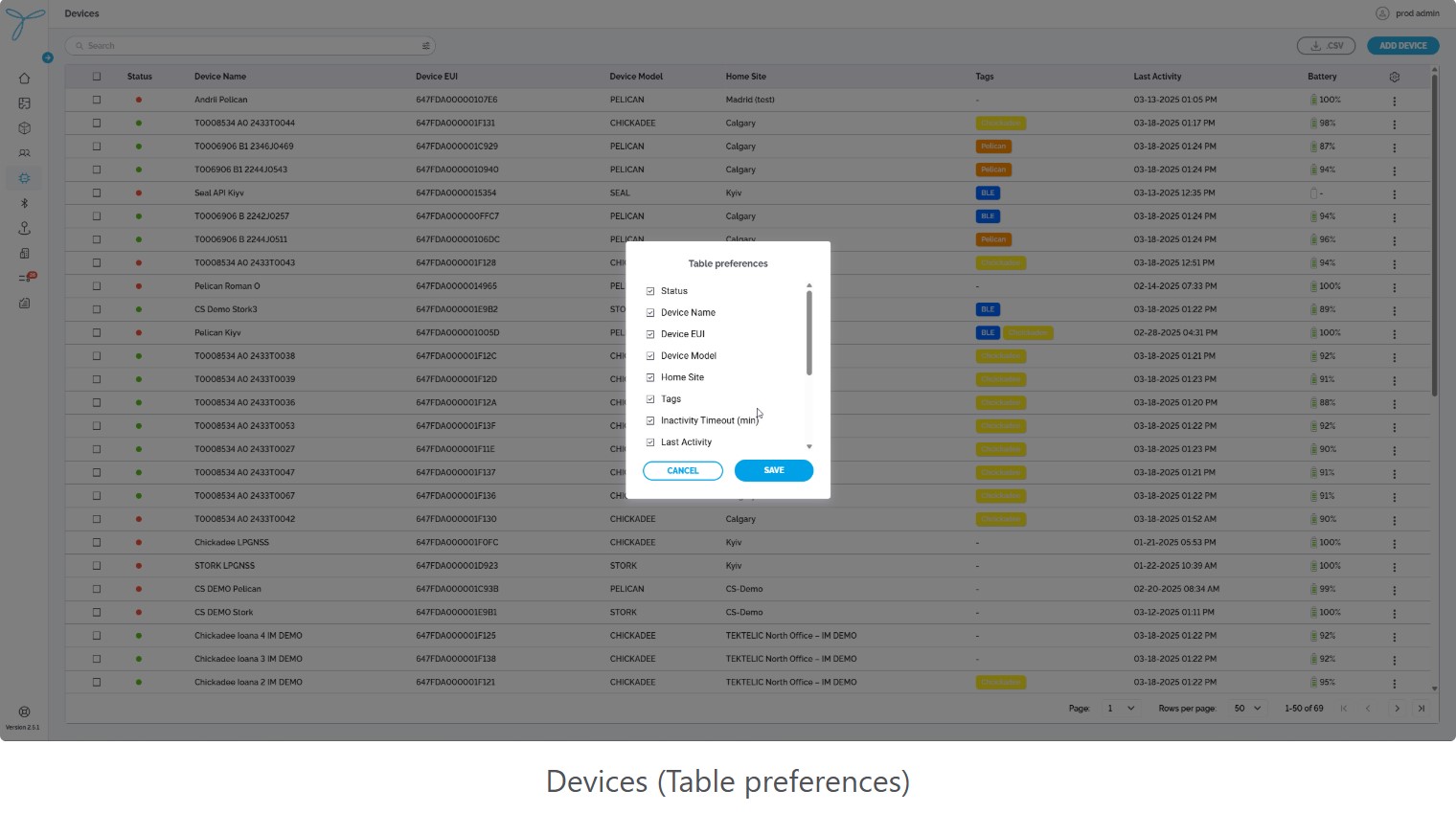
Detailed View
- Open the detailed view by clicking a device in the table (e.g., “TOO08534 AO 243370044”).
- The detailed view provides tabs for Details, with information about the device and its associated asset, as well as indoor/outdoor location data.
Conditions: You need admin permissions or explicit rights to add devices.
Modes:
-
With T-code/Revision/Serial Number:
-
Steps:
-
Click the Add Device button and select Manual.
-
In the Add Device modal, ensure the Manual tab is selected.
-
Enter the following fields:
- T-code/Revision/Serial Number (Required): Input the device identifier (e.g., “TOO0A0D0 on device label (bottom) packaging”).
- Inactivity Timeout (min) (Optional): Set a timeout (default is 30 minutes).
-
Click Next to proceed.
-
-
Expectations: The device is added to the system and can be paired with an asset.

-
-
Via DevEUI:
-
Steps:
-
Click the Add Device button and select Manual.
-
In the Add Device modal, ensure the Manual tab is selected.
-
Click the Add device with DevEUI link.
-
Enter the following fields:
- Device EUI (Required): Input the device’s unique EUI (e.g., “647FDA000001F136”).
- Device Name (Optional): Assign a name to the device.
- Inactivity Timeout (min) (Optional): Set a timeout (default is 30 minutes).
- Home Site (Required): Select from the dropdown (e.g., Calgary).
- Asset Name (Optional): Select an asset to pair with the device.
- Tags (Optional): Add tags for organization.
- Description (Optional): Add a note.
-
Click Save to create the device.
-
-
Expectations: The device is added and paired with the selected asset, if specified.
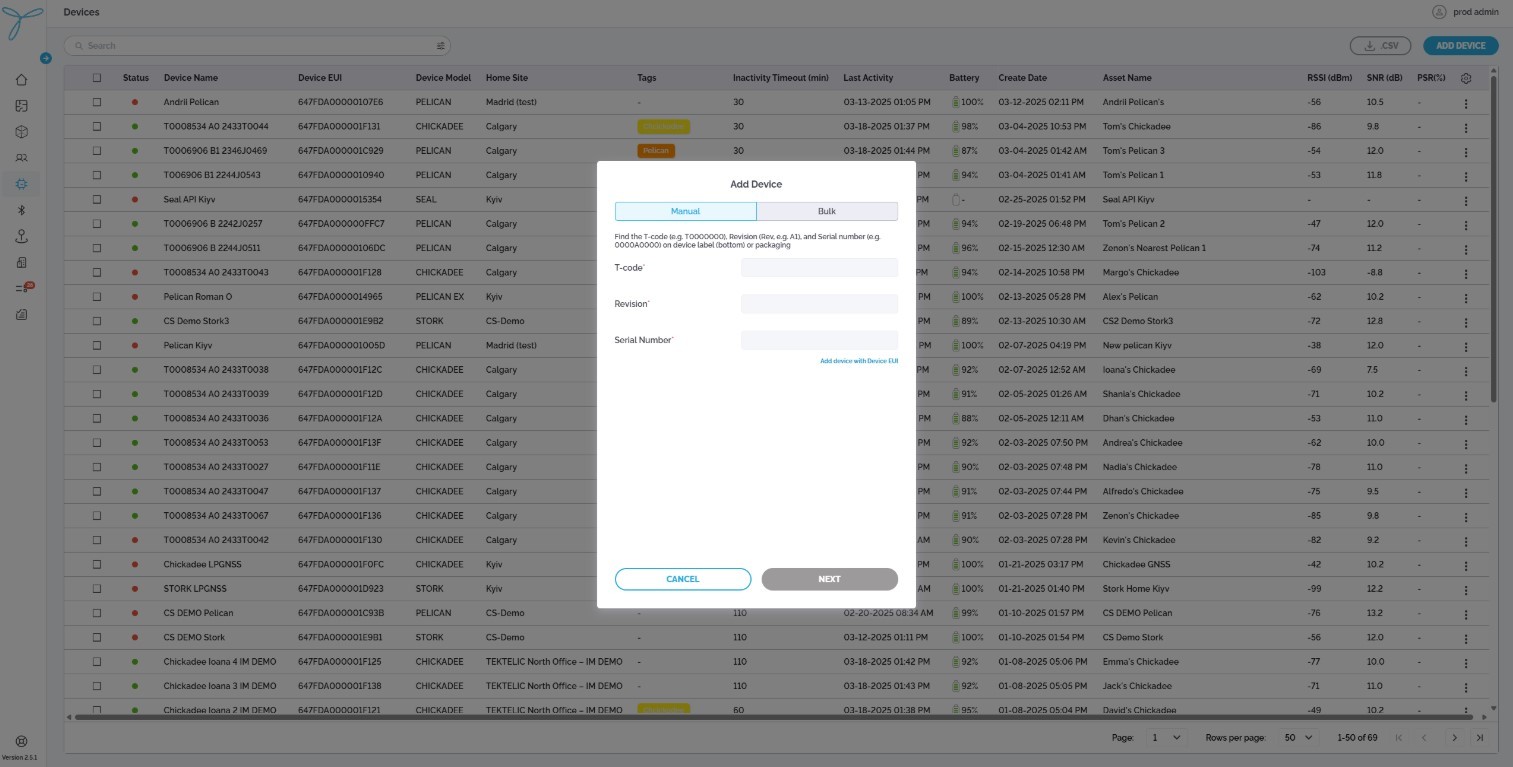
-
-
Bulk:
-
Steps:
-
Click the Add Device button and select Bulk.
-
In the Add Device modal, ensure the Bulk tab is selected.
-
Follow these steps:
- Download the CSV template file by clicking Download the CSV template file.
- Fill in the required fields (e.g., Device EUI, Device Name, Inactivity Timeout, Home Site, Asset Name) in the template.
- Upload the completed CSV file by dragging and dropping or using the Select File button (supports .csv files, maximum size 2MB).
-
Click Next to process the upload.
-
Review and confirm the data, then click Save.
-
-
Expectations: Multiple devices are added based on the uploaded CSV, appearing in the list for tracking
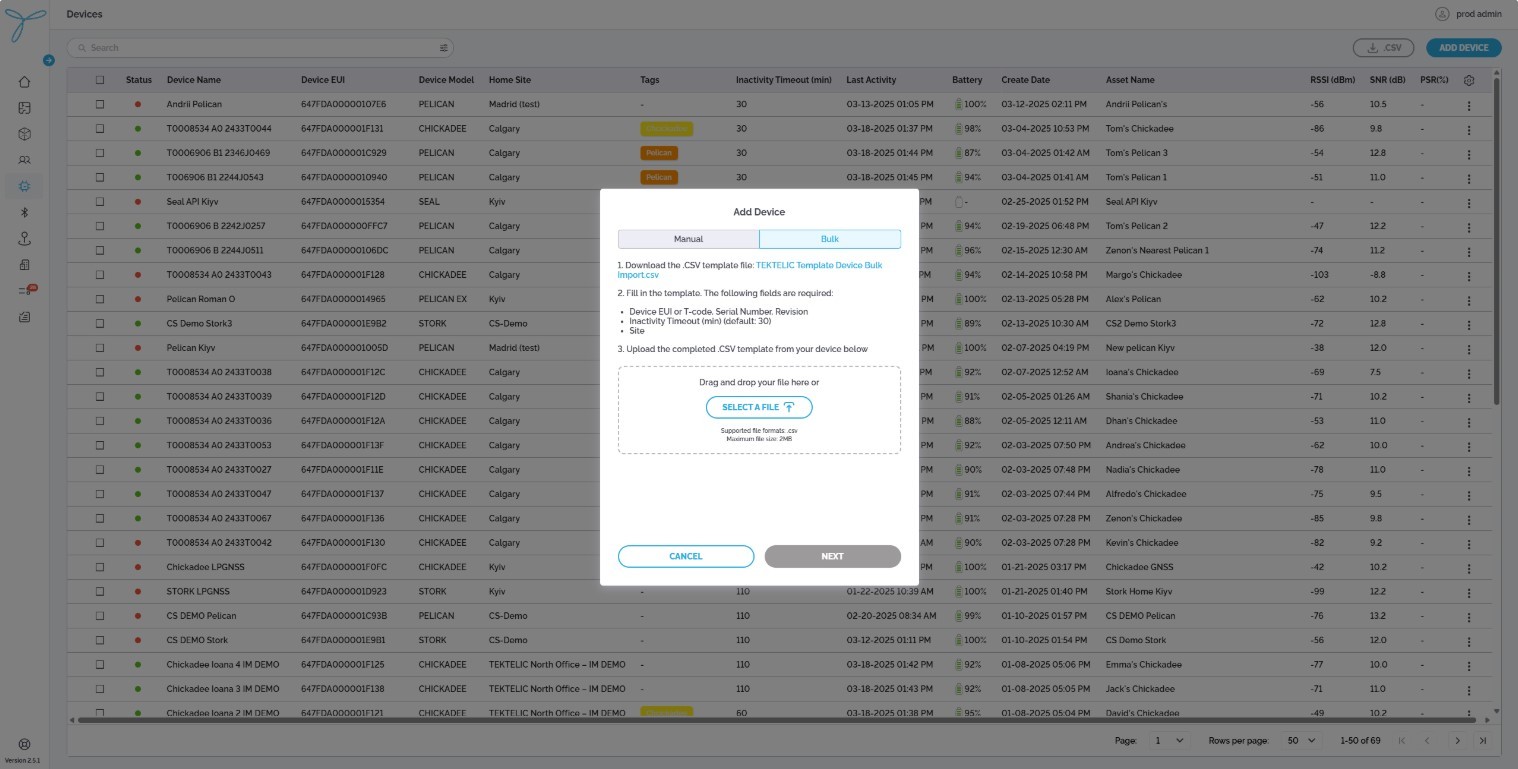
-
Conditions: You need admin permissions or explicit rights to edit devices. The device must already exist.
Modes:
-
From Main Table:
-
Steps:
-
Click the More Actions (…) button next to a device (e.g., “TOO08534 AO 243370044”) in the table.
-
Select Edit from the context menu to open the edit modal.
-
Update the following fields:
- Device Name (Editable): Update the name.
- Home Site (Editable): Change the site.
- Inactivity Timeout (min) (Editable): Adjust the timeout.
- Tags (Editable): Add or remove tags.
- Description (Editable): Update the note.
-
Click Save to confirm changes; Cancel to discard.
-
-
Expectations: The updated device reflects changes in the list and continues to be monitored.
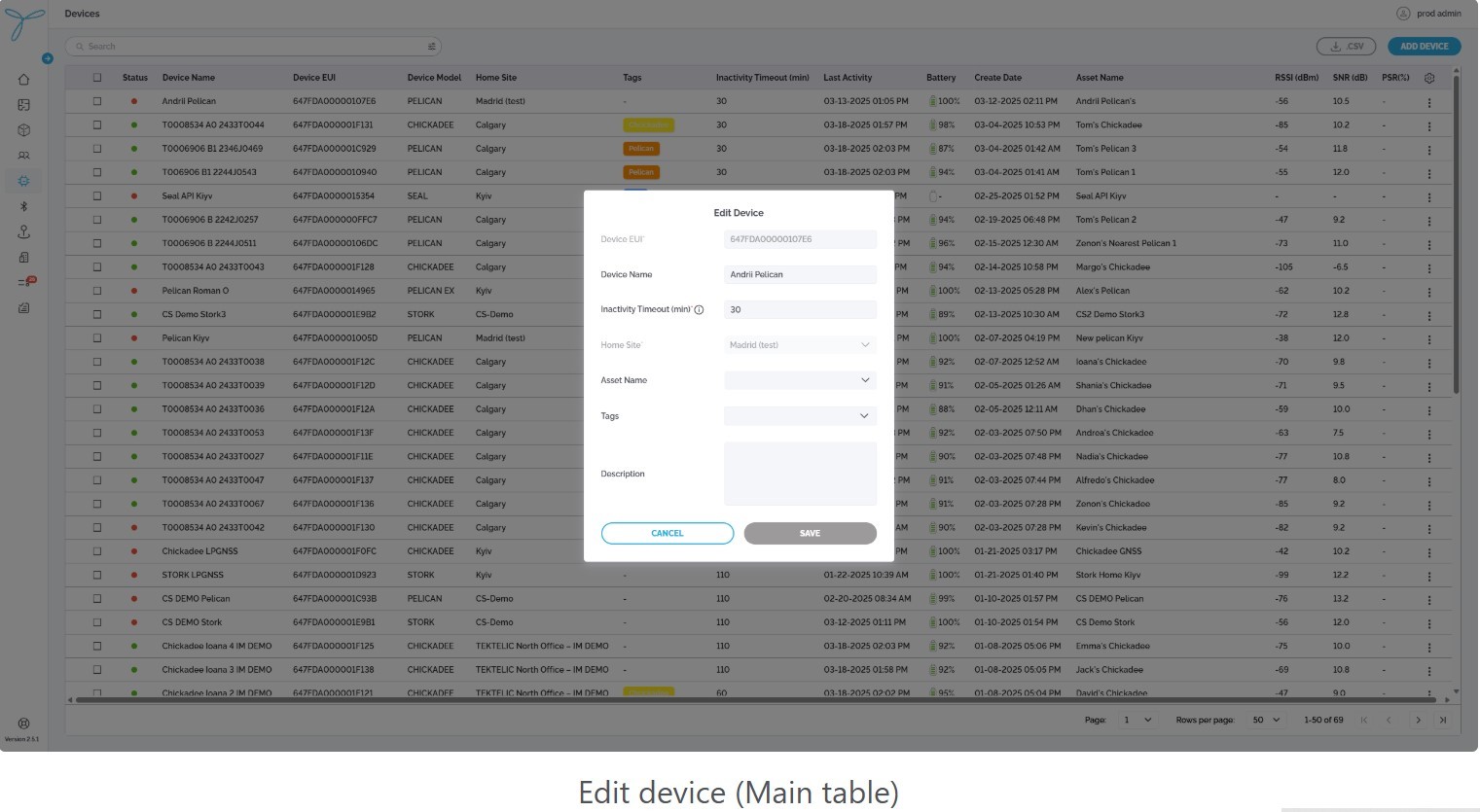
-
From Detailed View:
-
Steps:
- Open the detailed view of a device (e.g., “TOO08534 AO 243370044”).
- Click the pencil icon in the Details tab to edit fields.
- Update the same fields as above and save via the respective section.
-
Expectations: Same as above.
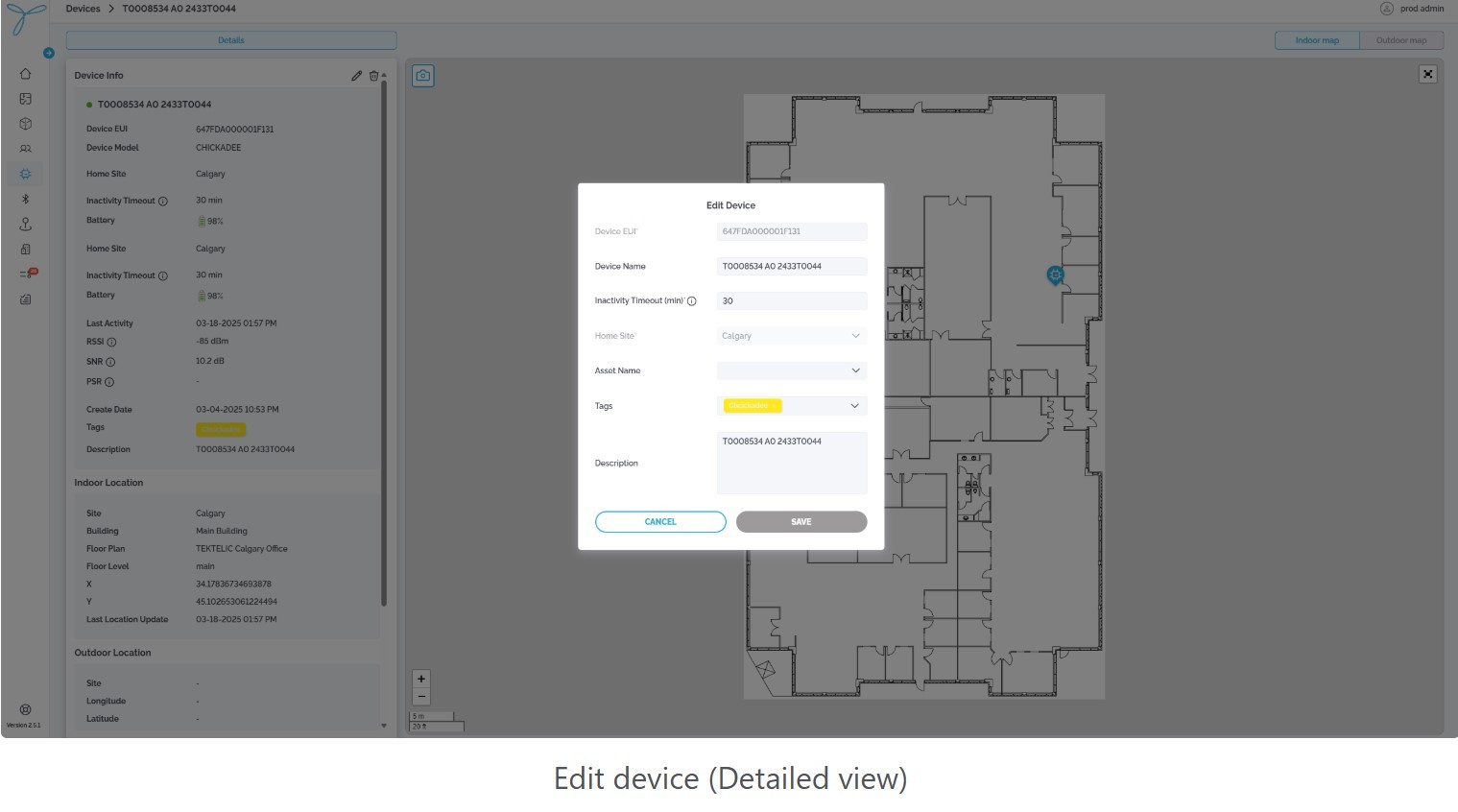
-
Conditions: You need admin permissions or explicit rights to delete devices. The device must not be linked to active event rules or assets.
Consequences: Deleting a device removes it from the system, unpairs it from any associated asset, and stops its tracking. This affects associated data, including historical records, location logs, event logs, and map visibility.
Modes:
-
From Main Table:
-
Steps:
- Click the More Actions (…) button next to a device (e.g., “TOO08534 AO 243370044”) in the table.
- Select Delete from the context menu to open the Confirm Delete Device modal.
- Review the warning about permanent deletion and its impacts (unpairing from assets, data loss).
- Click Delete to confirm; Cancel to abort.
-
Expectations: The device is permanently removed from the list and cannot be restored.
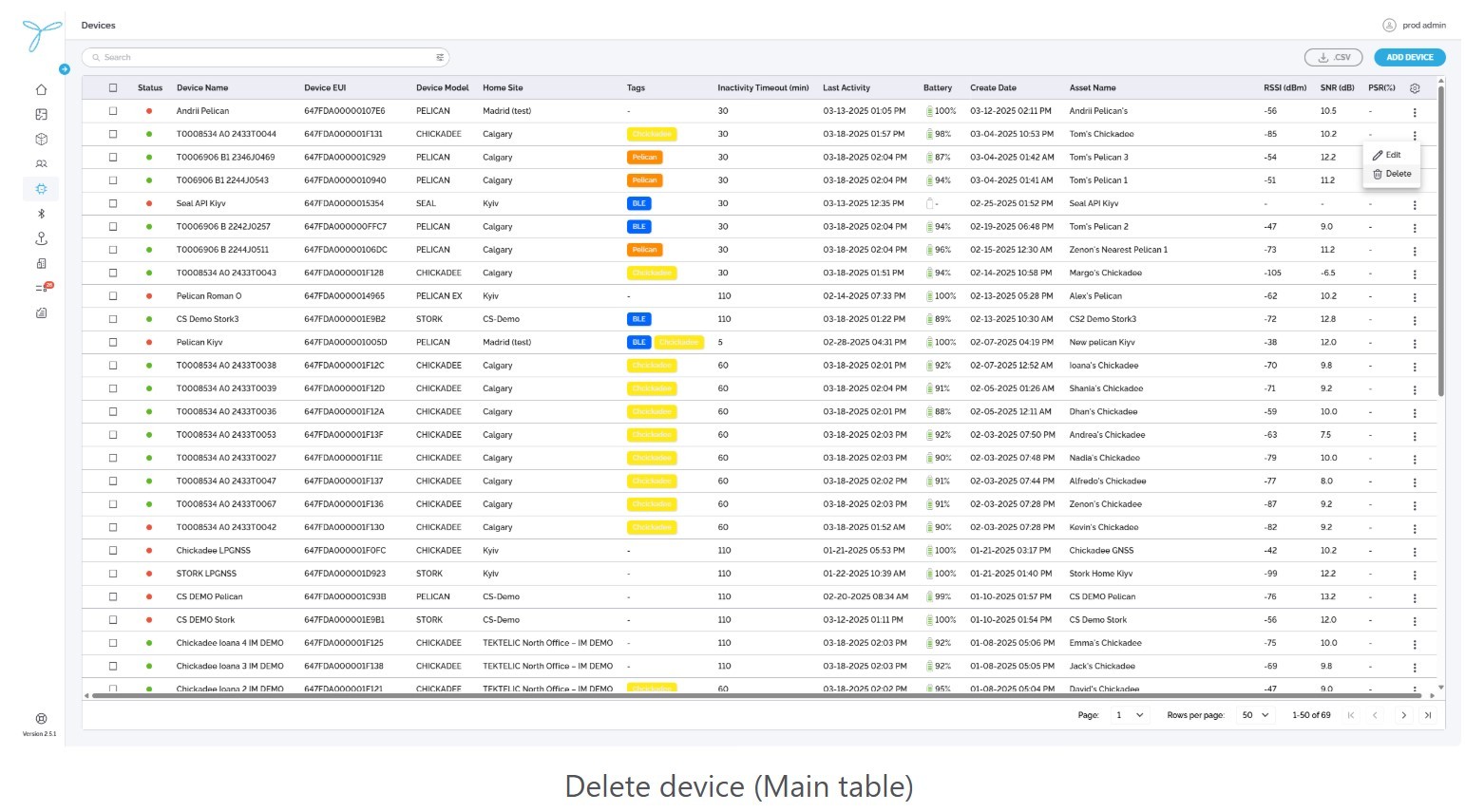
-
-
From Detailed View:
-
Steps:
- Open the detailed view of a device (e.g., “TOO08534 AO 243370044”).
- Click the trash icon (next to the pencil icon) to open the Confirm Delete Device modal.
- Review the warning about permanent deletion and its impacts (unpairing from assets, data loss).
- Click Delete to confirm; Cancel to abort.
-
Expectations: Same as above.
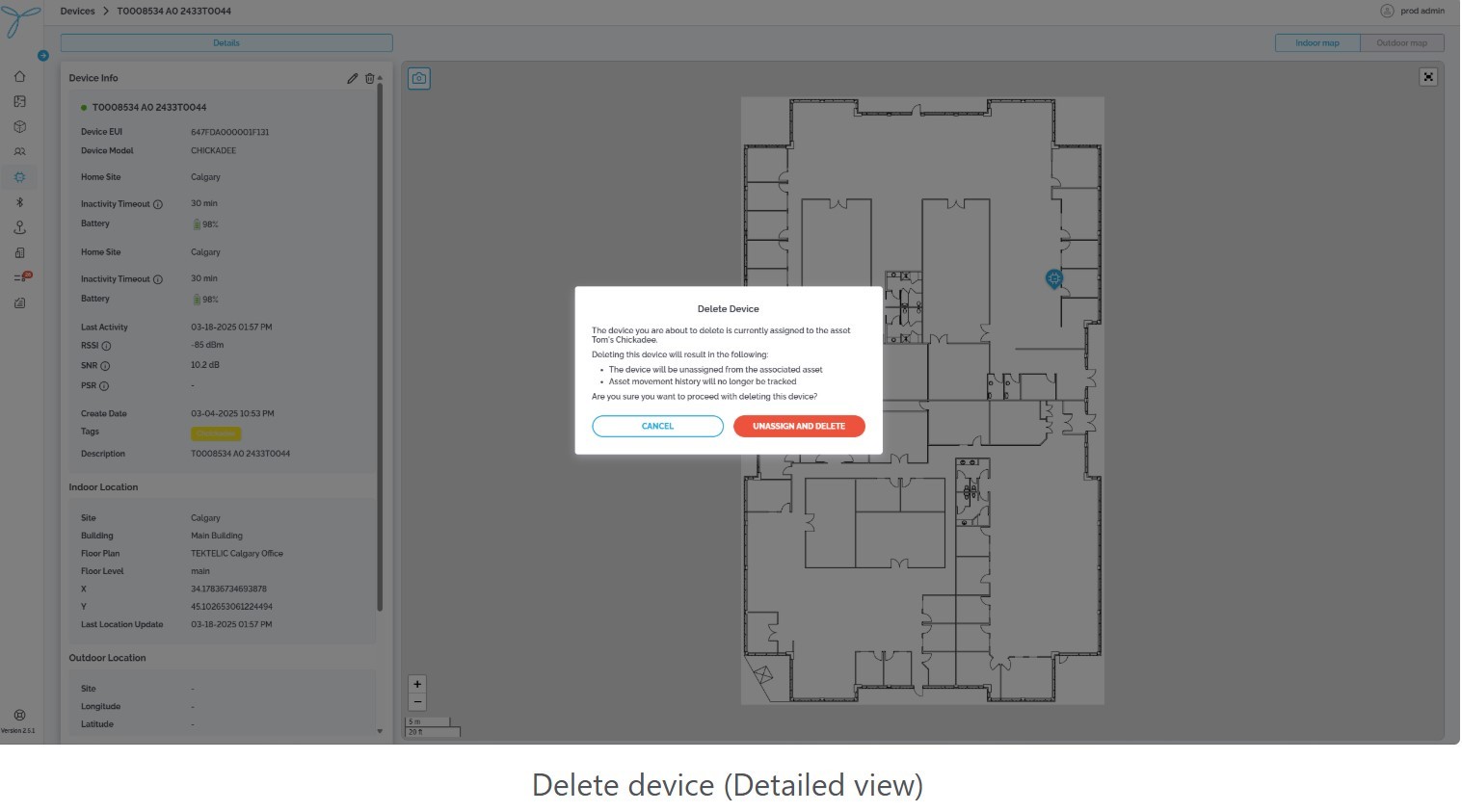
-
-
Details Tab:
-
Fields:
- Device Info: Device EUI, Device Model, Home Site, Inactivity Timeout (min), Battery, Last Activity, RSSI (dBm), SNR (dB), PSR (%), Create Date, Tags, Description.
- Indoor Location: Site, Building, Floor Plan, Floor Level, X(m), Y(m), Last Location Update.
- Outdoor Location: Site, Latitude, Longitude, Altitude, Last Location Update.
- Asset: Asset Name, Asset ID, Asset Type.
-
Actions: View indoor/outdoor map by switching between Indoor Map and Outdoor Map tabs. Toggle visibility with Visibility Preferences (if available).
-
Expectations: Displays real-time or last-known location data on the selected map.
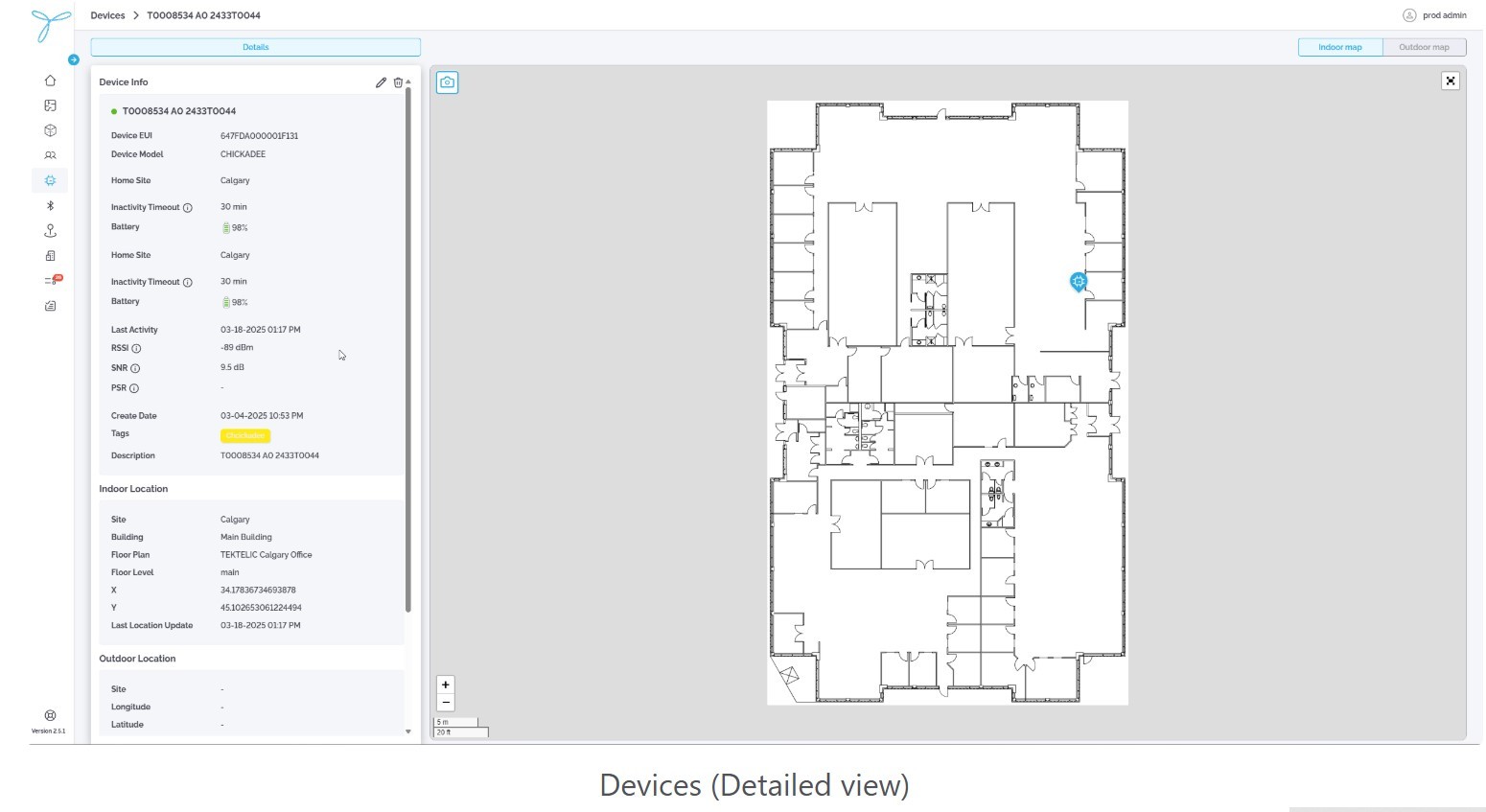
-
